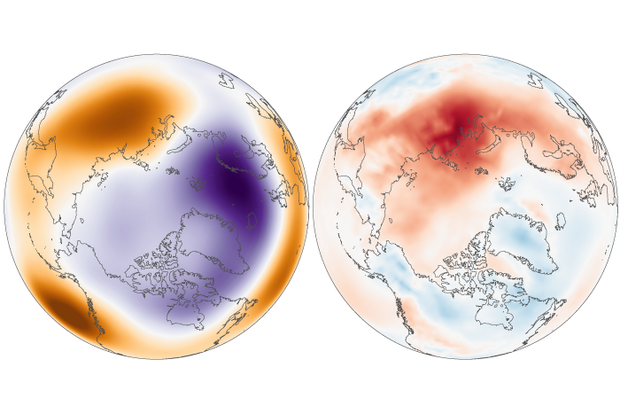Blogs
Because this is the Polar Vortex Blog, we would love to be able to tell you how the stratospheric polar vortex is doing super cool things that can explain how cold and snowy it’s been in many parts of the US this winter. But the truth is, in our opinion at least, while the stratosphere has been doing some interesting stretching and wobbling, there’s just not much evidence that this is really the main driver of our winter weather so far this year.
Little typical communication between the stratosphere and troposphere
As we have described before, one measure of “typical” downward coupling between the stratosphere and the troposphere are these plots showing the difference from average …
Read article
La Niña conditions continue, but forecasters estimate a 66% chance of a switch to neutral in March–May. This is looking like a weak and short La Niña. Also, while La Niña’s ocean conditions are currently weak, the atmospheric component is fairly strong. Today, I’ll cover current conditions, the forecast, and that mismatch between the ocean and atmosphere across the tropical Pacific Ocean.
Live in the moment
La Niña and its counterpart El Niño make up the El Niño/Southern Oscillation, or ENSO. La Niña’s characteristic cooler-than-average tropical Pacific surface water changes global atmospheric circulation in known ways, providing an early picture into potential upcoming temperature, ra…
Read article
The phrase “polar vortex” is often associated with words and phrases like “cold”, “sweater”, and “please, please, please don’t let my furnace break down now.” The disruption and weakening of the polar vortex winds do increase the odds of a cold air outbreak across the eastern US and northern Europe/Asia (but they don’t guarantee it). However, the polar vortex is a multi-faceted phenomenon. Read on to learn about the less-hyped side of the polar vortex.
There’s more to the polar vortex than just disruptions
We spent much of last season talking about the repeated disruptions in the polar vortex. This is when the stratospheric winds at 60 degrees North weaken substantially (or reverse di…
Read article
Right now, with La Niña conditions currently underway, I guarantee at least one of our readers is currently thinking “This alleged ‘La Niña’ is going to bust so hard in my region. It’s supposed to be DRY and it’s been WET so far. What the heck is wrong with you people!? BUST, BUST, BUST…” It’s frustrating! I get it! That’s because I too am human and get weirdly annoyed when the forecast is for something I want to happen, say 5 inches of snow, and then we end up with dry pavement. But, being a scientist, I also realize that weather and climate predictions contain uncertainty. And uncertainty stinks especially when you really want that outcome to materialize.
So, today I am going to try to …
Read article
We’re briefly popping in because another surge of very cold air looks to drop down from the Arctic over a large region of the central US this weekend and into early next week. We know that the question will be asked: is the cold related to the polar vortex this time? So here we are to provide some answers.
There are two points we want to emphasize:
1. The polar vortex strength, as measured by the speed of the winds around the 60N latitude circle and 10 hPa pressure level, remains stronger than average, and is currently forecast by most models to return to near-record strong wind speeds into early February.
Normally, if the polar vortex is communicating with the surface, which it…
Read article




